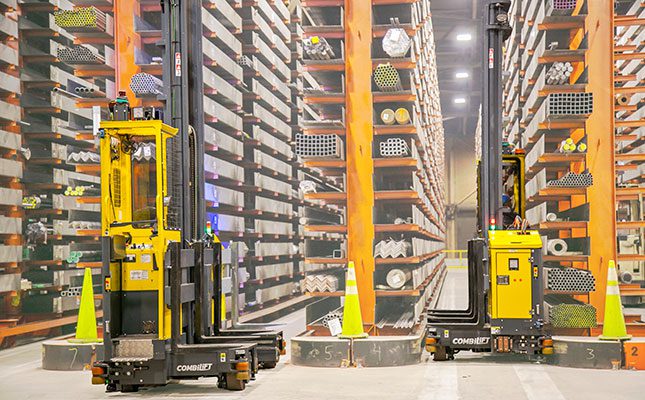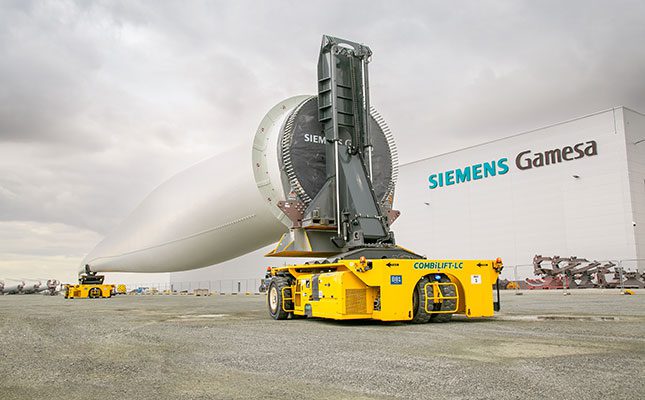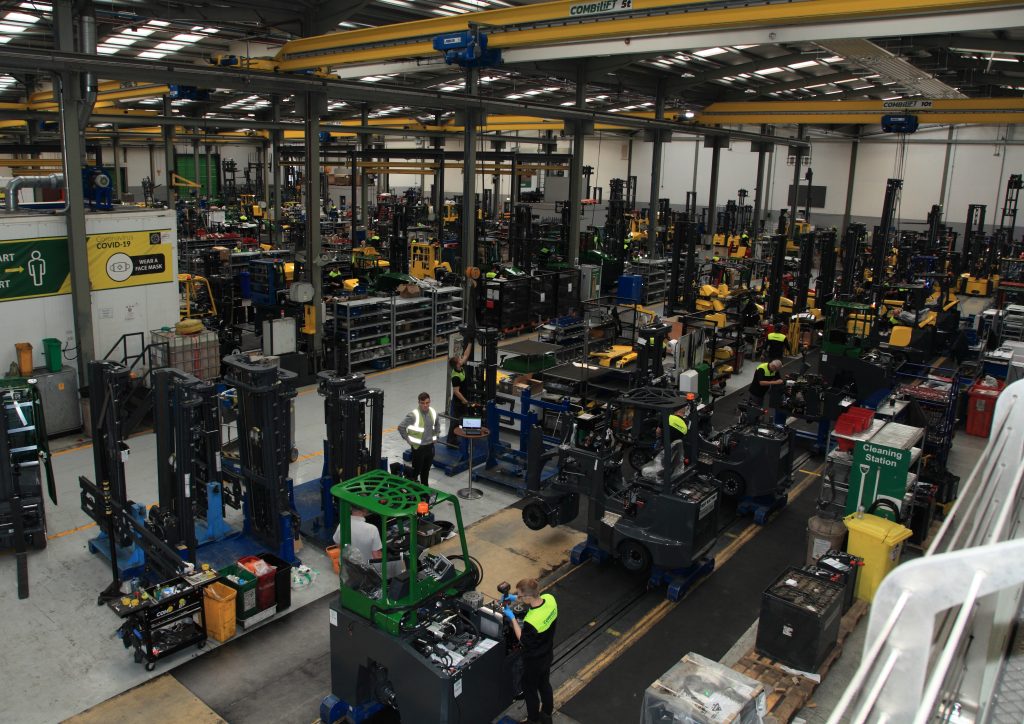
Photo: Comblift
Forklift company, Combilift, was founded by engineers Robert Mofett and Martin McVicar in 1998, when they pooled their expertise to build the world’s first internal combustion engine powered, all-wheel drive, multi-directional forklift.
They employed three people and produced 18 of these forklifts that year, of which one was sold locally and the others were exported.
Today, Combilift employs more than 800 people at its headquarters in Monaghan and global support offices, and produces 10 000 forklifts per year.
What is more, the company has established itself as the world’s leading innovator and manufacturer of multi-directional forklifts and straddle carriers, and recently launched the world’s first autonomous dual operational side loader for long loads, the Combi-AGT.
This autonomous forklift, which was showcased at the celebration, embraces the very latest in smart technology to carry loads of up to 5 tons in guided aisles and in free roaming. It also comes with a back-up manual mode in case of power outages or internet disruptions.
Investing in people
While it was impressive to see the Combi-AGT in action, the thing that wowed me even more was Combilift’s work culture and ethos.
The first thing I thought as we drove up to Combilift’s modern headquarters, was “this must be a nice place to work”.
The building seemed open and light, with a canteen near the entrance that looked out onto the green surrounding fields. I later discovered that 30% of the roof space was covered in skylights to enable staff to work in natural light.
Inside the open offices, the desk-workers had adjustable work stations, allowing them to either sit or stand while working, and timers to remind them not to sit for too long. The friendly staff, from the office to factory workers, were also eager to share information about their work.
While many first-world companies are taking manufacturing overseas due to a shortage of labour, Combilift has developed an in-house training and apprenticeship programme to develop skill and provide work experience for young people in the region.
Since the company has been running for 25 years, many of the first-generation workers’ offspring now also work at the company.
The company is also focused on sustainability for a better future. Energy is provided by solar panels, supplying 185kW of energy and a 1MW plant fuelled by recycled wood heat the spray booths and assembly area. Along with this, 110 000ℓ of rainwater are harvested annually for use throughout the facility.
The company also strives to carry out sustainable procurement, with a large proportion of their annual sourcing coming from suppliers in Ireland.
Creating solutions
The company is highly dedicated to innovative solutions aimed at improving warehouse efficiency and safety.
In testimony to this, it launched another two solutions, in addition to the Combi ACT, during their celebration. The first is the Combi Blade Mover and Load Carrier, which has been developed to meet the load handling demands of large-scale offshore wind turbine manufacturers.
The solutions consist of two remote control units that can work in tandem master-and-slave mode, to move wind turbines blades and towers of up to 115m in length and 70 tons in weight through production stages and on to storage locations, which can sometimes be as far as 5km apart. The solution also allows the stacking of load, much closer than was previously possible.

Combilift expects to generate more than €50 million (about R997m) per year in this market segment by 2026, and has already signed a multimillion Euro order with Siemens Gamesa.
Josh Moffett, heavy equipment manager at Combilift, said during the launch that the scale of offshore wind projects around the world led to a unique set of challenges, one of which was the ability to transport the very large components that create wind, a wind turbine.
“We recognised this and used our expertise in load handling to develop a solution to support those in the industry. The product is specifically made to order and therefore can be uniquely customised to fit specifications.”
The second solution is Combi-Connect, a tele-matic software product that provides real-time data on fleet performance that is integrated into actionable insights through advanced analytics.
As such, the solution unlocks a new level of operational efficiency, predictive maintenance, and informed decision-making.
“With telematics fleet management, small and effective changes can bring big results, big savings and a more effective fleet management,” explained Combilift engineer Antonio Patacho. Combilift also launched two other solutions in the past year.
The Combi CB 70E, which is currently the most compact 7 ton counterbalance truck available on the market, while also benefitting from multidirectional ability, enabling the versatile space saving handling of bulky loads.
The forklift comes with a patented Independent Front and Rear Traction negating the need for a differential lock on slippery surfaces and significantly reducing long-load momentum twisting when travelling sideways.
The Combi Cube was my favourite at the warehouse. It looks like an ordinary forklift, but operates like a hovercraft. What makes it most impressive is its ability to switch directions, without having to stop to change weight positioning.
It also offers a high level of driver comfort, with the seat, for instance, automatically swivelling 15 degrees to the left or right, with the selected direction of travel, to maximise driver visibility and reduce strain when travelling in reverse.

PHOTO: Glenneis Kriel
Efficiency and safety
While this is not new, it is good to know that Combilift offers a free warehouse planning consultancy service to help customers unlock the full potential in their warehouse.
Their powerful, precision-lifting technology allows the full exploitation of vertical space, while multidirectional operation enables the manoeuvring of long loads in narrower aisle.
Combilift claims that “the switch from ordinary forklifts to their solutions is enabling their clients to substantially increase, and in some cases, even double storage capacity in their existing footprint”.
In addition, the machines are designed to reduce fleet size, by effectively becoming three forklifts in one: a side loader, counterbalance and narrow aisle forklift.
All its products are specifically developed with safety at the forefront, as the company believes that “putting safety first does not just protect the workforce, but leads to other wide-ranging benefits such as improved productivity and more cost-effective operation”.
Combilift is also a leader in the development of pedestrian forklifts. The demand for these forklifts has increased significantly over the past few years, because it is considered safer to have forklifts operated on foot, and at a walking speed, than to have a driver in a cab.
Combilift’s range has a multi-position tiller arm, which enables push button rotation of the rear wheel, and the operator to stand at the side of the truck. This is the safest position when placing and picking in narrow aisles, as it improves visibility and greatly reduces the risk of incidents in tight confines.
About 70% of Combilift’s forklifts are electric. Most of the them are still equipped with lead acid batteries, although they are lithium ready.
McVicar explained that they would stick with lead-acid batteries until a cost-effective way has been developed to recycle lithium batteries.
McVicar ascribed the success of the company to its continued focus on innovating customised solutions for customers. The company continuously reinvests 7% of its revenue in Research and Development each year.
Many of the solutions they have developed and commercialised are still part of their production line today, with almost all the units they have sold so far, to their knowledge, still running.
Visit combilift.com.










